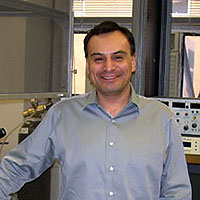Juan Marcos Alarcon, Ph.D.

- Title
- Assistant Professor
- Department
- Division of Neuroscience
- Institution
- State University of New York, Downstate Medical Center
- Address
-
450 Clarkson Avenue, Box 25
Office location: 4-113 - City, State, ZIP
- Brooklyn, NY 11203
- Country
- United States
- [email protected]
- Website
- http://www.downstate.edu/pathology/Dr.JuanMarcosAlarconPhD.html

- Research field
- Neuroscience
- Award year
- 1999
- Country of origin
- Chile
- Mentor name
- Eric R. Kandel, M.D.
Research
Modern physiological and molecular biological studies have shown that enduring changes in synaptic efficacy, a process known as synaptic plasticity, is a fundamental neuronal process underlying various forms of learning and memory. Research in this area has provided useful insights into how the expression of a given type of synaptic plasticity modulates and perhaps reconfigures the activity of the neural network in which this occurs. In the brain most neurons receive multiple synaptic inputs which are potentially capable of inducing synaptic plasticity. This raises a question central to an understanding of how information is processed and stored within a given neuronal circuit, i.e., how are two or more forms of synaptic plasticity integrated at the level of a single neuron? Our work focuses on an examination of the functional properties of the interaction between distinct forms of synaptic plasticity elicited within a neuron. A neuron expressing multiple forms of synaptic plasticity might selectively encode new incoming information and, thus, dramatically modulate both the way that it filters relevant from irrelevant information as well as the way that it exports this information to other cells. We are initially addressing these questions by examining the interaction between distinct forms of synaptic plasticity elicited in different dendritic compartments within the CA1 area of the rodent hippocampus via electrophysiological determinations in vitro slices. Specifically, we ask:
1) How does a neuron integrate various forms of synaptic plasticity elicited in multiple synapses?
2) What are the cellular and molecular mechanisms underlying this process?
3) What impact does this process have on signal integration at neuronal and network level?
4) And, most importantly, is this process relevant for the encoding of memories?
We expect to obtain insights into the functional significance of specific synaptic plasticity associations or interactions between synaptic inputs arriving from different brain regions. The understanding of the rules that result in the prevalence or dismissal of certain forms of synaptic plasticity within a neuron could provide additional insights into the cellular basis of learned behavior.